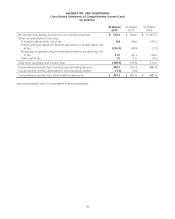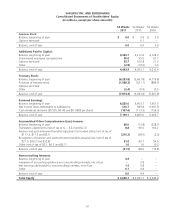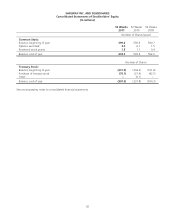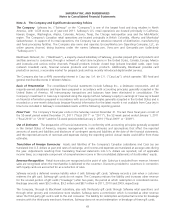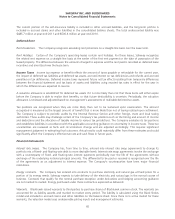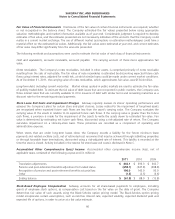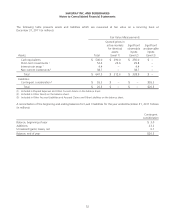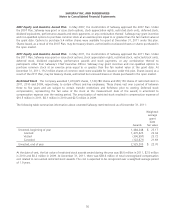Safeway 2011 Annual Report Download - page 64
Download and view the complete annual report
Please find page 64 of the 2011 Safeway annual report below. You can navigate through the pages in the report by either clicking on the pages listed below, or by using the keyword search tool below to find specific information within the annual report.
SAFEWAY INC. AND SUBSIDIARIES
Notes to Consolidated Financial Statements
Fair Value of Financial Instruments Disclosures of the fair value of certain financial instruments are required, whether
or not recognized in the balance sheet. The Company estimated the fair values presented below using appropriate
valuation methodologies and market information available as of year end. Considerable judgment is required to develop
estimates of fair value, and the estimates presented are not necessarily indicative of the amounts that the Company could
realize in a current market exchange. The use of different market assumptions or estimation methodologies could have a
material effect on the estimated fair values. Additionally, the fair values were estimated at year end, and current estimates
of fair value may differ significantly from the amounts presented.
The following methods and assumptions were used to estimate the fair value of each class of financial instruments:
Cash and equivalents, accounts receivable, accounts payable. The carrying amount of these items approximates fair
value.
Notes receivables The Company’s notes receivables, included in other assets, is comprised primarily of notes receivable
resulting from the sale of real estate. The fair value of note receivables is estimated by discounting expected future cash
flows using interest rates, adjusted for credit risk, at which similar loans could be made under current market conditions.
As of December 31, 2011, the carrying value of notes receivables, which approximates fair value, was $134.4 million.
Long-term debt, including current maturities. Market values quoted in public markets are used to estimate the fair value
of publicly traded debt. To estimate the fair value of debt issues that are not quoted in public markets, the Company uses
those interest rates that are currently available to it for issuance of debt with similar terms and remaining maturities as a
discount rate for the remaining principal payments.
Store Lease Exit Costs and Impairment Charges Safeway regularly reviews its stores’ operating performance and
assesses the Company’s plans for certain store and plant closures. Losses related to the impairment of long-lived assets
are recognized when expected future cash flows are less than the asset’s carrying value. The Company evaluates the
carrying value of the assets in relation to its expected future cash flows. If the carrying value is greater than the future
cash flows, a provision is made for the impairment of the assets to write the assets down to estimated fair value. Fair
value is determined by estimating net future cash flows, discounted using a risk-adjusted rate of return. The Company
calculates impairment on a store-by-store basis. These provisions are recorded as a component of operating and
administrative expense.
When stores that are under long-term leases close, the Company records a liability for the future minimum lease
payments and related ancillary costs, net of estimated cost recoveries that may be achieved through subletting properties
or through favorable lease terminations, discounted using a risk-adjusted rate of interest. This liability is recorded at the
time the store is closed. Activity included in the reserve for store lease exit costs is disclosed in Note C.
Accumulated Other Comprehensive (Loss) Income Accumulated other comprehensive income (loss), net of
applicable taxes, consisted of the following at year-end (in millions):
2011 2010 2009
Translation adjustments $ 402.1 $ 393.3 $ 302.7
Pension and post-retirement benefits adjustment to funded status (658.1) (447.8) (408.8)
Recognition of pension and post-retirement benefits actuarial loss 196.0 145.0 95.9
Other (1.5) (2.5) (3.6)
Ending balance $ (61.5) $ 88.0 $ (13.8)
Stock-Based Employee Compensation Safeway accounts for all share-based payments to employees, including
grants of employee stock options, as compensation cost based on the fair value on the date of grant. The Company
determines fair value of such awards using the Black-Scholes option pricing model. The Black-Scholes option pricing
model incorporates certain assumptions, such as risk-free interest rate, expected volatility, expected dividend yield and
expected life of options, in order to arrive at a fair value estimate.
46


